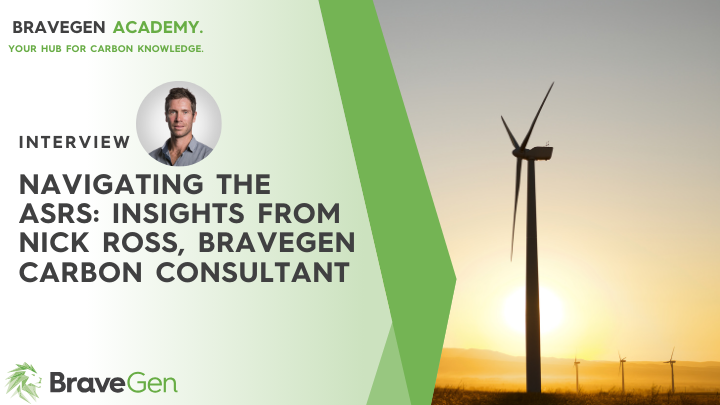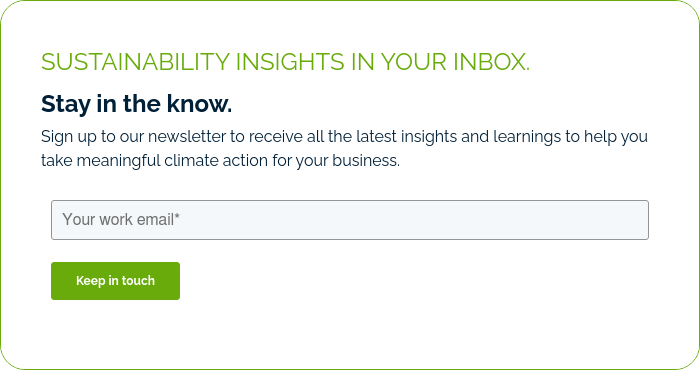"Companies can’t afford to exclude emissions on a whim. They need a clear rationale for every decision," Nick emphasises. He also recommends documenting decisions and assumptions as you progress. “You don’t want to be scrambling at the 11th hour to remember the logic behind a decision you might have made 9 months earlier,” he notes.
Companies should not discount the complexity, even if they're already reporting to NGERS or voluntary standards such as Climate Active. "There will be a steep learning curve, particularly for Group One companies, who will be the first to report under the ASRS."
The road to carbon reduction.
While reporting is a key focus of the ASRS, Nick wants to remind businesses that carbon reduction is the ultimate goal. Companies will be required to disclose their emissions, set targets and demonstrate progress towards those targets in subsequent reporting periods.
"It’s one thing to measure your emissions, but making tangible progress against your goals is ultimately where the real challenge lies for all of us," he says. "The legislation is designed to drive action, not just reporting."
For many organisations, this will require a drastic change in how they approach sustainability. Nick notes that scenario analysis and quantifying physical climate risk will bring challenges for businesses unfamiliar with these processes.

"In New Zealand, we saw scenario analysis requiring specialist input and focus, and we expect the same impacts in Australia with ASRS," he stresses.
"Assigning a dollar value to physical climate risk is a whole new ball game for many companies," he explains. "It’s going to be challenging, but necessary to meet the legislative requirements."
The role of technology in compliance.
As sustainability reporting becomes more complex, the reliance on technology and software tools will become crucial for organisations looking to improve productivity and deliver data quality to efficiently comply with the ASRS.
Nick, who transitioned from consultancy to BraveGen after his systems outgrew spreadsheets, is a strong advocate for leveraging digital solutions.
"Spreadsheets can only take you so far," he says. "When dealing with the complexity required for ASRS reporting, and stepping up to more frequent reporting, you need a robust system that can support transparency and accuracy."

The cost of implementing sustainability software is often a concern for companies, but Nick is quick to point out the improved productivity, and the hidden costs of not investing in the right tools.
"Yes, software has a cost, but the cost of getting it wrong is much higher. There’s the risk of failed audits, fines, and reputational damage. Plus, the time and effort spent manually crunching numbers can quickly add up," he explains. "Investing in the right technology will pay off many times over."
The importance of early preparation.
One of Nick’s key messages to sustainability professionals is the importance of early preparation. Although some companies may feel they have time, especially with the one-year relief for Scope 3 reporting, the reality is that businesses need to act now.
"Even if you're in Group Two or Three, which at the surface level have an extra 1 to 2 years to prepare, however, you’re likely part of the supply chain for Group One companies," Nick says. "Those Group One companies will need your emissions data for their Scope 3 reporting, so it’s only a matter of time before you’re pulled into the process."
For smaller companies, this could mean a rapid acceleration in sustainability efforts as they respond to requests from their larger counterparts.
"Supply chain pressure will come fast, and companies that haven’t started preparing will struggle to keep up," he warns.
A broader context: Australia vs. New Zealand.
When asked how Australia’s sustainability regulations compare to New Zealand’s, Nick notes that while New Zealand is ahead in timing, with the Climate-Related Disclosures (CRD) legislation coming into effect earlier, Australia’s ASRS covers a larger proportion of the economy.
Both require a range of information to be disclosed, which broadly aligns with the Task Force on Climate-related Financial Disclosure (TCFD) framework, the four pillars being:
- Governance
- Strategy
- Risk Management
- Metrics and targets
"While there are nuances, both countries are moving in the same direction, aiming to meet their Nationally Determined Contributions (NDCs) under the Paris Agreement," he explains.
Nick believes that as international commitments tighten, the pressure on Australian companies to meet their targets will only grow. He points to potential risks for exporters and supply chains if Australia fails to meet its climate commitments.
"There’s a real risk that trade partners will impose tariffs or other barriers if they see Australia as lagging on its climate goals," he says. "For companies, this means that sustainability isn’t just a compliance issue—it’s a business risk."
Next steps: Embrace the future of carbon accountability.
Businesses are now facing a new era of accountability and transparency. For sustainability professionals, the message is clear: forward-looking businesses are managing the transition better, so start preparing now.
"Get ahead of the curve," Nick advises. "Invest in the right tools, engage your supply chain, and be transparent in your processes. The sooner you start, the better prepared you’ll be for the challenges ahead."
For those navigating this new regulatory environment, Nick’s practical, finance-driven approach offers valuable insights. While the road to compliance may be daunting, the long-term benefits—for both business and the planet—are well worth the effort.
Ready to simplify your ASRS compliance journey? Let’s talk about how BraveGen can help your team start strong. To learn more, reach out to us using the button below.


